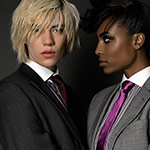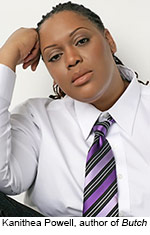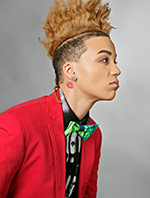Review of Butch by Kanithea Powell

The definition of the term butch is an often-contested word within the LBTQ community. More often than not, the definitions of butch are driven by appearance, such as the “soft-butch,” the wo(man) that displays hints of masculinity, such as short-hair, and the “stone-cold” butch, a (wo)man that exhibits a strong masculine build.
Powell, the author of the photo book Butch, believes that there are not just two versions of ‘butch,’ but a butch spectrum. Powell and her photographer, Alford, photographed fourteen models (most of whom identify as LBTQ) in the span of two days. Powell notes that she let “everyone bring a little bit of their own flavor to the set.” It was the photographic medium that enabled her to “challenge what ‘butch’ really means” (11). The resulting photographic product, Butch, includes over 100 photographs of (wo)men split into four sections (i) Bois, (ii) Suits, (iii) Just the two of us, and (iv) Never judge a butch by her cover.

Powell chose models that displayed “little bit of androgyny, a little bit of softness, and a lot of strength.” She wanted to highlight the masculine traits of each model, while highlighting the femininity of each (wo)man. She explains, “even though a woman appears to be masculine, to me, she is still very feminine [a (wo)man].” In contrast to Joan E. Biren’s classic 1970s butch lesbians “at work,” in Eye to Eye: Portraits of Lesbians, Alford’s photographs evoke a postfeminist aura. Placed outside of their natural contexts, Powell’s models stand in front of a colored backdrop and appear to be highly stylized in makeup, suits, torn jeans, and hipster hoodies. Rather than conveying ‘butch-like’ qualities through their actions, these models express their masculinity through their body and clothes. Each (wo)man’s gaze may be strong, but the artificial ‘setting’ rips them from their agency. Flipping through the photos, I began to wonder how these (wo)men would display their masculine or feminine traits outside the picture frame.
The BOIS section opens with a photograph of beautiful African-American (wo)man sitting on stool. Next to this photograph, Powell’s words read, “we live in a world full of cynical people who seek to strip us of the very things that make us original. It takes bravery to be genuine.” This is a poetic and strong statement; one that does not seem to compliment the photograph. If taken out of context, the photographs in Butch appear to be less genuine and more similar to photos you might find in any top fashion magazine, such as Vogue or W Magazine.
Since the book is titled Butch, I also found my self searching (or maybe judging) each (wo)man based on my own expectations of what butch means. It seems that the title itself, acts as a violent label that infers judgment. How are we not supposed to judge a butch by their cover, if the cover of the book is “Butch”?

Seeking to open the identity box that often confines and enact violence on individuals, Powell is a woman who steers clear of labels, she identifies as a woman who loves women. Similarly, she hopes her book, Butch, expands and/or queers the stereotypical meanings of butch. She writes, “We are all apart of each other – (wo)man, female-blended perfectly together creating one complete being.” Rather than offering a ‘butch’ spectrum, however, most of the models appear to hold similar levels of feminine and masculine traits, leaving the viewer hungry for more. Where was the stone butch? Powell’s intentions are genuine and heartfelt, but each woman seems to be contained and constructed by Powell’s words and her own subjective understanding of what makes a (wo)man ‘butch.’ Her book is another box. Powell can offer her perspective, but a (wo)man’s identity is individual and unique. Butch will always be an individual identity that no form of media will ever be able to uncover. It is up to the (wo)man to express herself. Which leads me to ask the following questions: Can we ever queer a butch or any type of identity without creating a new box? Can we ever not judge a butch by her cover?
Photos by Qwest Films


